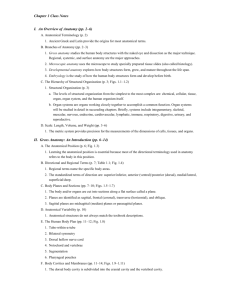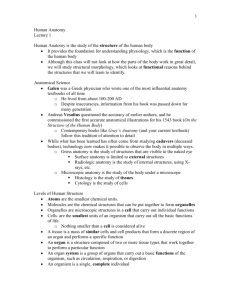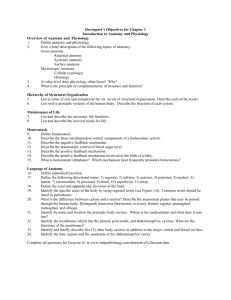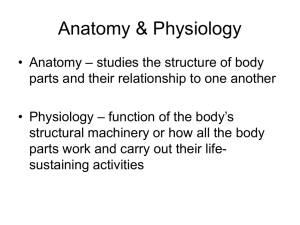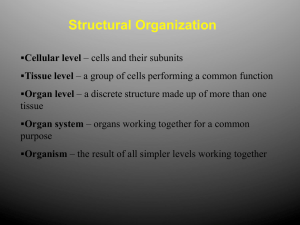Chapter 1 Notes - Las Positas College
advertisement
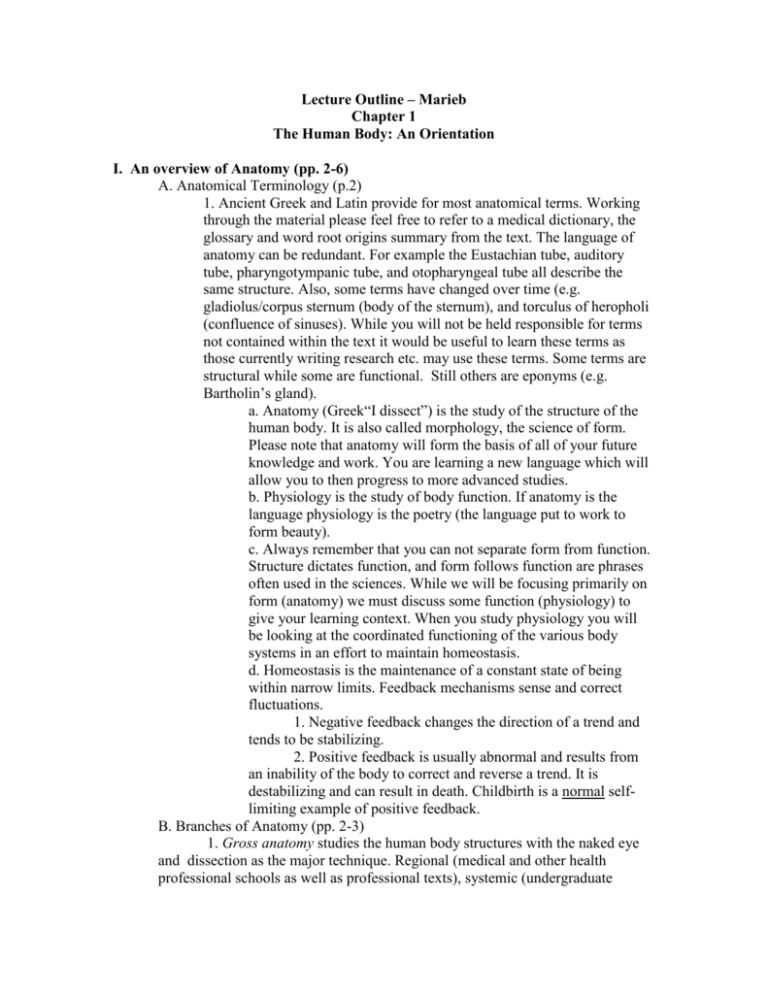
Lecture Outline – Marieb Chapter 1 The Human Body: An Orientation I. An overview of Anatomy (pp. 2-6) A. Anatomical Terminology (p.2) 1. Ancient Greek and Latin provide for most anatomical terms. Working through the material please feel free to refer to a medical dictionary, the glossary and word root origins summary from the text. The language of anatomy can be redundant. For example the Eustachian tube, auditory tube, pharyngotympanic tube, and otopharyngeal tube all describe the same structure. Also, some terms have changed over time (e.g. gladiolus/corpus sternum (body of the sternum), and torculus of heropholi (confluence of sinuses). While you will not be held responsible for terms not contained within the text it would be useful to learn these terms as those currently writing research etc. may use these terms. Some terms are structural while some are functional. Still others are eponyms (e.g. Bartholin’s gland). a. Anatomy (Greek“I dissect”) is the study of the structure of the human body. It is also called morphology, the science of form. Please note that anatomy will form the basis of all of your future knowledge and work. You are learning a new language which will allow you to then progress to more advanced studies. b. Physiology is the study of body function. If anatomy is the language physiology is the poetry (the language put to work to form beauty). c. Always remember that you can not separate form from function. Structure dictates function, and form follows function are phrases often used in the sciences. While we will be focusing primarily on form (anatomy) we must discuss some function (physiology) to give your learning context. When you study physiology you will be looking at the coordinated functioning of the various body systems in an effort to maintain homeostasis. d. Homeostasis is the maintenance of a constant state of being within narrow limits. Feedback mechanisms sense and correct fluctuations. 1. Negative feedback changes the direction of a trend and tends to be stabilizing. 2. Positive feedback is usually abnormal and results from an inability of the body to correct and reverse a trend. It is destabilizing and can result in death. Childbirth is a normal selflimiting example of positive feedback. B. Branches of Anatomy (pp. 2-3) 1. Gross anatomy studies the human body structures with the naked eye and dissection as the major technique. Regional (medical and other health professional schools as well as professional texts), systemic (undergraduate studies), and surface anatomy (any health professional must know) are the major approaches. 2. Microscopic Anatomy uses the microscope to study specially prepared tissue slides (also called histology). 3. Developmental anatomy explores how body structures form, grow, and mature throughout the life span. 4. Embryology is the study of how the human body structures form and develop before birth. C. The Hierarchy of Structural Organization (p. 3; Figs. 1.1-1.2) 1. Structural Organization (p.3) a. The levels of structural organization from the simplest to the most complex are: chemical, cellular, tissue, organ, organ system, and the human organism itself. b. Organ systems are organs working closely together to accomplish a common function. Organ systems will be studied in detail in succeeding chapters. Briefly, systems include integumentary, skeletal, muscular, nervous, endocrine, cardiovascular, lymphatic, immune, respiratory, digestive, urinary, and reproductive. Please note the difference between the cardiovascular system and the circulatory system. The circulatory system includes the cardiovascular and lymphatic systems. D. Scale: Length, Volume, and Weight (pp. 3-6) 1. The metric system provides precision for the measurements of the dimensions of cells, tissues, and organs. Gross Anatomy: An Introduction (pp. 6-14) A. The Anatomical Position (p.6; Fig 1.3) 1. Learning the anatomical position is essential because most of the directional terminology used in anatomy refers to the body in this position. B. Direction and Regional Terms (p. 7; Table 1.1; Fig. 1.4) 1. Regional terms name the specific body areas. 2. The standardized terms of direction are: superior/inferior, anterior (ventral)/posterior(dorsal), medial/lateral, superficial/deep. C. Body Planes and Sections (pp. 7-10; Figs. 1.5-1.7) 1. The body and/or organs are cut into sections along a flat surface called a plane. 2. Planes are identified as sagittal, frontal (coronal), transverse (horizontal), and oblique. 3. Sagittal planes are midsagittal (median planes or parasagittal planes. D. Anatomical Variability (p.10) 1. Anatomical structures do not always match the textbook descriptions. E. The human Body Plan (pp. 11-12; Fig. 1.8) 1. Tube-within-a-tube 2. Bilateral symmetry 3. Dorsal hollow nerve cord 4. Notochord and vertebrae 5. Segmentation 6. Pharyngeal pouches F. Body Cavities and Membranes (pp. 11-14; Figs. 1.9-1.11) Please note that most body cavities are potential spaces filled with viscera, tissues, and fluids. 1. The dorsal body cavity is subdivided into the cranial cavity and the vertebral cavity. a. The cranial cavity houses the brain. b. The vertebral cavity runs through the vertebral column and encloses the spinal cord. 2. Three serous cavities are all enclosed body cavities with no openings to the external surface of the body. a. The pericardial cavity surrounds the heart. b. The pleural cavity surrounds the lung. c. The peritoneal cavity surrounds the abdominopelvic viscera. 3. Several smaller cavities of various types are located mostly in the head (p.14) a. The oral and nasal cavities with openings to the external surface of the body are lined with mucous membranes. b. Orbital cavities house the eyeballs. c. Middle ear cavities are located within the temporal bones of the skull and house the tiny ear ossicles. d. Synovial cavities are joint cavities. G. Abdominal Regions and Quadrants (p. 14; Fig. 1.12) 1. The abdomen is divided into nine regions: the right and left hypochondriac region, the epigastric region, the right and left lumbar regions, the umbilical region, the right and left iliac region, and the hypogastric region. III. Microscopic Anatomy: An Introduction (pp. 15-17, Fig. 1.13) A. Microscopy is the examination of the fine structure of organs, tissues, and cells. (pp. 14-15) B. Preparing Human Tissue for Microscopy (pp. 16-17) 1. Specimens for LM or TEM must be fixed (preserved) and then cut into sections (slices) thin enough to transmit light or electrons. C. Scanning electron microscopy provides three-dimensional pictures of whole, unsectioned surfaces. (p. 16) D. When preserved tissue has been exposed to many procedures this can cause minor distortions called artifacts. (pp. 16-17) IV. Clinical Anatomy: An Introduction to Medical Imaging Techniques (pp. 17-21) A. X-Ray imaging (pp. 17-18; Fig. 1.14) 1. Traditional X-ray images continue to play a major role in medical diagnoses involving bone and abnormal dense structures such as a tumor. B. Advanced X-Ray Techniques (p. 18; Figs. 1.15-1.19) 1. Computed tomography (CT) or computed axial tomography (CAT) produces improved X-ray images that are computer enhanced for clarity. 2. Dynamic special reconstruction (DSR) produces three-dimensional images of body organs that can be rotated. 3. Xenon CT is used to diagnose a stroke (a blockage or cutting off of blood flowing to the brain). 4. Digital subtraction angiography imaging (DSA) produces sharp images of blood vessels injected with a contrast medium. C. Positron emission tomography tracks radioisotopes in the body, locating areas of high energy consumption and high blood flow. (p.19; Fig. 1.17) D. Sonography (ultrasound imaging) provides sonar images of developing fetuses and internal body structures, such as an enlarged liver. (pp. 19-20; Fig. 1.18) E. Magnetic resonance imaging (MRI) subjects the body to strong magnetic fields and radio waves, producing high-contrast images of soft body parts. (pp. 20-21; Fig. 1.19)

